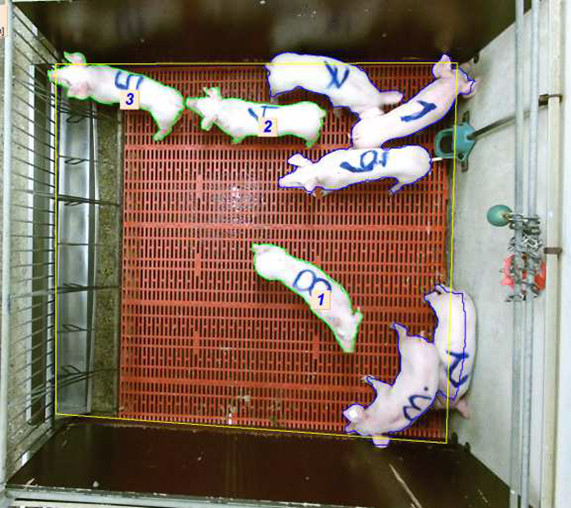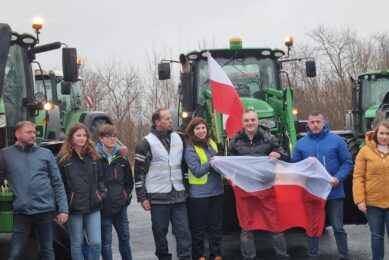EU pig space allowance may fall short in reality

EU legislation with regard to space allowance for grower pigs may have to be revised when pigs are kept in small groups.
Recent scientific research has shown that in some body weight classes, pigs need almost the entire space required by legislation only for their bodies. Thus, the question arises whether for welfare reasons, pigs have to be allowed more minimum space than is currently in the laws.
That outcome was shared by Dr Michaela Fels of the University of Veterinary Medicine, Hanover, Germany. She presented a study, which she did together with a team of other researchers, at the 8th European Conference on Precision Livestock Farming (PLF), held September 12-14 in Nantes, France.
Adequate space allowance for growers
Dr Fels explained that adequate space allowance is important for ensuring animal welfare in pig farming. European legislation, the following minimum spacing requirements apply:
• Pigs 5-10 kg: 0.15 m2/kg
• Pigs 10-20 kg: 0.20 m2/kg
• Pigs 20-30 kg: 0.30 m2/kg
Would that be sufficient? That was the key question for the researchers when embarking on a study using automatic image analysis in order to evaluate these EU requirements.
A pig’s need for space
The researchers, she told, divided a pig’s need for space into 3 different usages:
• Static space: Space needed for the pigs’ bodies
• Dynamic space: Space needed for species-specific behaviour
• Social-interaction space: Space for social interaction between the animals.
The static space is ‘used space’ because it is occupied by the bodies. The last 2 bullet points, she said, can be called ‘free space’. The free space is not covered by the pigs’ bodies and is available for different behavioural activities such as postural adjustments or social interactions. The researchers therefore aimed to figure out whether it was possible to quantify the free space, by measuring the static or used space of pigs in a pen. For that, they used an image-based monitoring system, provided by CLK in Germany. In combination with software for image analysis, a 3D-camera was mounted at 2.5 m above the pen.
Automatically detecting static space
During the trial, in each of 3 batches, 2 groups of 8 piglets were formed after weaning (35th day of life). This way, the static space covered by the piglets’ bodies in different positions was detected automatically during 6 weeks.
Measurements were done weekly during 1 hour in the morning, every 10 seconds. The area covered by a group of 8 piglets increased almost linearly with increasing body weight until week 6, the research team wrote in their abstract.
In week 6, the maximum amount of static space covered was measured. The pigs, weighing on average 25.2 kg then occupied together 1.72 m2, when all were lying without huddling. In the same week, the mean space covered by the 8 growers was 1.5 m2.
Realistic results on static space requirements
By the automatic method, realistic results on the static space occupied by piglets kept in groups were achieved. When comparing these outcomes to the EU spatial requirements, the researchers found that piglets (10-20 kg) kept in groups of 8 covered up to 91% of the pen size required by EU-legislation by their bodies alone. Again, in comparison to the EU regulations, piglets weighing 20-30 kg needed 63% on average for their static space and maximum of 72% when they were all lying.
Also, the researchers wrote, it became evident that piglets kept in groups of 8 always covered more than 60% of the space required by EU-legislation by their bodies. Thus, less than 40% remain for behavioural activities.
A suitable method to provide reliable results
The researchers concluded that the new method for measuring piglets’ static space based on image analysis was shown to be suitable to provide reliable results concerning the space that is needed by the body dimensions of pigs kept in groups.
They added that their study was not primarily intended to enhance legal space requirements for pig production, however to demonstrate the amount of free space which remains in a pen after deduction of the space needed by the pigs’ bodies. Nevertheless, Dr Fels admitted that, in case a room is covered by 91% by bodies, the free space left is ‘not very much’, and that one could wonder whether that is sufficient to carry out natural behaviour or to separate lying and dunging areas.
The research was done by M. Fels, K. Konen and N. Kemper of the University of Veterinary Medicine, Hanover, Germany; E. Hessel of the Georg-August-University of Göttingen, Germany; and C. Bonk and C. Cruse of the company CLK, Altenberge, Germany. K. Konen is attached to both universities.











